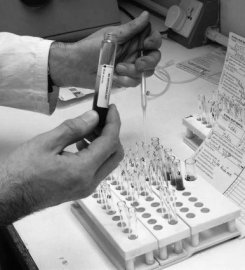 An infected person's HIV subtype is a better predictor than viral load for determining rapid death from AIDS, say Johns Hopkins scientists. Traditional viral load testing is used by health workers to monitor the progression of a HIV infection to AIDS. As a benchmark, a viral load of more than 75,000 particles per cubic milliliter of blood generally equates to rapid progression of the disease.
An infected person's HIV subtype is a better predictor than viral load for determining rapid death from AIDS, say Johns Hopkins scientists. Traditional viral load testing is used by health workers to monitor the progression of a HIV infection to AIDS. As a benchmark, a viral load of more than 75,000 particles per cubic milliliter of blood generally equates to rapid progression of the disease. But it seems that viral load is not always an accurate indicator, and basing mortality estimates on the subtype of virus may be more accurate. The Hopkins researchers found that having viral subtype D made a person with HIV likely to die more rapidly compared to a person with subtype A. Ten percent of those infected with subtype D died within three years, while none with subtype A died. However, viral load ranged from 20,000 particles per cubic milliliter of blood to 100,000 particles per cubic milliliter of blood in those with both subtypes, and was consequently not found to be an accurate predictor of rapid death.
The participants in the study were newly infected men and women from Uganda with 53 becoming infected with subtype A and 203 infected with subtype D. Another 70 were infected with a recombinant version of both subtypes. Although the quantity of virus infecting these individuals was roughly the same for each subtype, average years of survival for each subtype differed widely: 9 years for A, 7 years for D and 6 years for type AD.
The researchers believe that subtype D is more virulent than subtype A because D has the ability to bind to key receptors on immune cells, allowing subtype D to kill more quickly. Subtype A of the virus can bind to only to one kind of receptor, known as CCR5,while the subtype D virus can bind to both CCR5 and another receptor, CXCR4. Two-thirds of those infected with the type D virus died within three years.
"Knowing a person's HIV subtype is important for the management of the infection because the disease can progress more rapidly in those infected with subtype D and recombinant virus incorporating subtype D than in those with other subtypes," concluded lead researcher Oliver Laeyendecker.
Based on material from John Hopkins University School of Medicine

